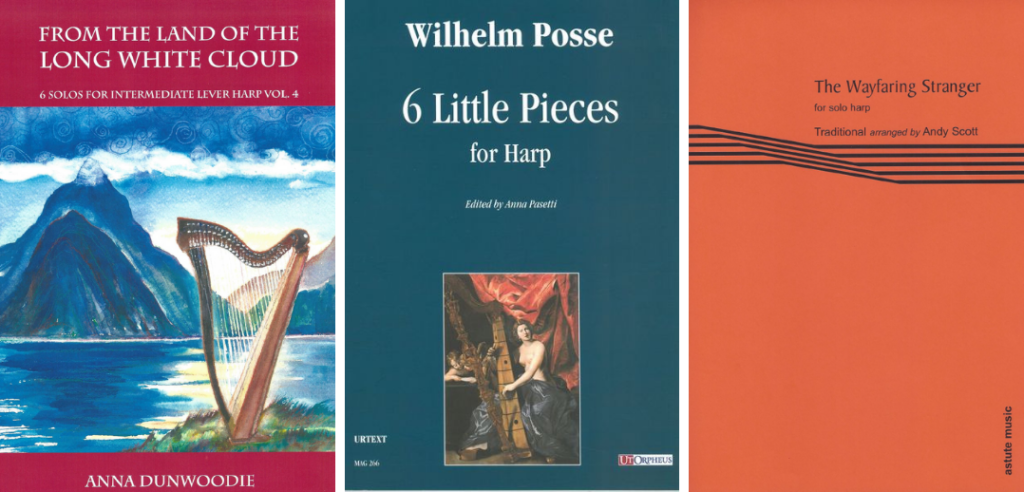
As the reality of a second year of challenging existence sinks in, we are forced to abandon dreams of returning to pre-pandemic life for a while. It’s important to stay focused and find new sources of inspiration. Fortunately, the harp is the most beautiful instrument in the world, and music is the best form of therapy. Here are some new publications that might lift your (and your listener’s) COVID-weary spirits.
Creighton’s Collection has published some original music by New Zealander Anna Dunwoodie, From the Land of the Long White Cloud. This is volume four in the series, containing six solos for intermediate lever harp. The music is completely diatonic. Most pieces are in the key of G or D major with one selection in E-flat. The composer says that most of her creations have a story behind them, and she shares that interesting background in the front of the book.
“West Park Waltz” is an engaging piece with a simple accompaniment. “Skerryvore” is a lament in 6/8. “Vinegar Hill” is an air, played at a brisk pace. She provides a second version of this tune for melody instrument with harp accompaniment. “Bev’s Fancy” is a slow reel that Dunwoodie describes as in the style of O’Carolan. “Fru Sally” is also a slow reel and contains some larger reaches for the left hand. The final tune is “Mrs. Raewynn Robertson,” another air. She provides a separate harmony line that could be played on a melody instrument to accompany the harp.
No fingering is suggested, but all the pieces fall comfortably within the hands. Pedal harpists may enjoy them as well, as they are mostly sight-readable and they would add a Celtic flavor to a set. All the pieces are lovely, pleasing melodies, so let them nurture your spirit.
For something in a more classical style, we turn to the harp virtuoso Wilhelm Posse. In addition to transcribing works written for other instruments, including piano pieces by Liszt and Chopin, Posse composed a wide range of pieces for the harp. UtOrpheus has re-published Posse’s 6 Little Pieces for Harp, edited by Anna Pasetti. It is noted in the preface that this edition is based on the first printing, published in 1910, and that “no correction to the text was necessary.” It isn’t clear exactly what was edited by Pasetti. Perhaps she added the barely visible dotted lines connecting the pedal change marking to the enharmonic equivalent for which it is moved, as in “Nachtstück” (Nightpiece). Regardless of who put them there, they are too faint to be useful. The traditional method of circling the synonym would be more obvious.
As is typical of music from that era, not all pedal changes are included. It would have been helpful if Pasetti had provided the missing pedal markings. Also, the accidental markings are so tiny that is difficult to see them. Otherwise, the typesetting is easy to read and printed on cream-colored stock and oversized pages.
The shortest piece is “Lied ohne Worte” (Song without Words) at just over one page in length. It uses an Alberti-style left hand that imparts a music box quality. No pedal notation is provided on this piece. “Träumerei” (Dreaming)” is in a pulsing 6/8 time signature and has frequent, sometimes tricky pedal changes. “Neckeri” (Teasing) is probably the easiest piece and just two pages. “Gavotte” has some very large chords that may be difficult to reach. “Kleiner Marsch” (Little March) should help with drilling rhythm.
Don’t confuse “little” with “easy.” These compositions are not easy or beginner level, but they have a lot to offer, especially for students at the early intermediate level. None of the major harp music vendors seemed to have this in their catalog, so it may have been out of print for a while. It is worth reviving this charming collection, and teachers may want to add this to their required repertoire list.
Finally, here’s something traditional presented in a contemporary style. Astute Music has published an arrangement of “The Wayfaring Stranger” by Andy Scott and edited for pedal harp by Lauren Scott. The three-page arrangement takes about four minutes to play. It is available both in a print version and as a download.
The publisher describes it as a “harmonic journey with twists and turns through many keys; fairly chromatic at times, simple and open at other times.” This is an apt description, and, as this portrayal suggests, there is a lot of footwork required. All the pedal markings appear in the middle of the staff where you won’t miss them, and to ensure that, they are printed in red. The typesetting is easy to read and notation for muffling and damping is included in appropriate spots.
The piece opens with harmonics, and the melody begins in the left hand. There are some large, expansive chords and some dissonant, unusual, and jazzy harmonies. Intermediate players will find it challenging, but attainable. Fortunately, you can listen and watch this on the publisher’s website and see a sample page before you purchase. Check it out and decide for yourself if this is for you. •
Jan Jennings has been the music review editor for Harp Column since 1993. She is an active freelancer and teacher, and is the author of The Harpist’s Complete Wedding Guidebook and Effortless Glissing. Email her at
mail@harpbiz.com.







